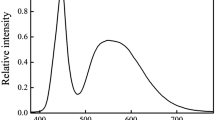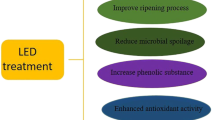Abstract
The effects of light emitting diode (LED) irradiation on maintaining freshness and nutrition in cabbage during low temperature storage were investigated. Cabbage, ‘Dongdori’ was stored at 4–5°C for 18 days under white, green, blue, and red LED light. On day 15 of storage, the total chlorophyll content of cabbage was highest for green, followed by white, red, blue, and a nonirradiated control group. The vitamin C content was highest for blue, followed by white, green, red, and the control. On day 18 of storage, the total polyphenolic content in cabbage was highest for blue followed by white, red, green, and the control. LED irradiation is effective for enriching the chlorophyll, vitamin C, and polyphenol contents of cabbage stored at a low temperature and results suggest that LED colors have different effects.
Similar content being viewed by others
References
Doi M, Shigenaga A, Emi T, Kinoshita T, Shimazaki K. A transgene encoding a blue-light receptor, phot1, restores blue-light responses in the Arabidopsis phot 1, pho2 double mutant. J. Exp. Bot. 55: 517–523 (2004)
Lee HI. Analysis of light utilization efficiency of artificial lighting sources for plant production. MS thesis, Chonbuk National University, Jeonbuk, Korea (2011)
TIME Magazine. 10 Foods that pack a wallop. Available from: http://time.com/time/magazine/article/0,9171,1001676-2,00.html. Accessed Jan. 21, 2002.
Rural Development Administration. Development of Environmental Friendly Cultivation Technology of Salad Cabbage in Highland and Postharvest Quality Management for Fresh Market. 2nd Year Completion Report of RDA. Rural Development Administration, Suwon, Korea. pp. 1–46 (2009)
Lee YS, Kim YH, Kim SB. Changes in the respiration, growth, and vitamin C content of soybean sprouts in response to chitosan of different molecular weights. Hortic. Sci. 40: 1333–1335 (2005)
Shewfelt RL. Sources of variation in the nutrient content of agricultural commodities from farm to the consumer. J. Food Qual. 13: 37–54 (1990)
Fankhauser C, Chory J. Light control of plant development. Annu. Rev. Cell Dev. Biol. 13: 203–229 (1997)
Food and Drug Administration. The 995 Food Code, Recommendations of U.S. Department of Health and Human Services. U.S. Public Health Service, Washington, DC, USA (2009)
Notification No. 2012-100 of the Korea Food and Drug Administration ministry of finance and economy. Food Code. 1-1-8. Korea Food and Drug Administration, Osong, Korea (2012)
Park SY, Chang MS, Choi JH, Kim BS, Lee HR, Ham KH. Effect of a refrigerator with led on functional composition changes and freshness prolongation of cabbage. Korean J. Food Preserv. 14: 113–118 (2007)
UCDAVIS Postharvest Technology Maintaining Produce Quality & Safety. Cabbage (round & Chinese types): Recommendations for maintaining postharvest Quality. Available from: http://postharvest.ucdavis.edu/pfvegetable/Cabbage/. Accessed Nov. 4, 2013.
The Food Marketing Institute with Cornell University cooperative extension. The Food Keeper: A Consumer Guide to Food Quality and Safe Handling. University of Hawaii at Manoa, HI, USA. p.7 (2010)
Chae SK. (Standard) Food Analysis: Theory and Practice. Jigu Publishing Co., Paju, Korea. pp. 545–551, 576–578 (2006)
Kim HJ, Jun BS, Kim SK, Cha JY, Cho YS. Polyphenolic compound content and antioxidative activities by extracts from seed, sprout and flower of safflower (Carthamus tinctorius L.). J. Korean Soc. Food Sci. Nutr. 29: 1127–1132 (2000)
SPSS Institute Inc. Statistics Version 18.0 for Windows. Statistical Package for Social Sciences Inc., Chicago, IL, USA (2010)
Kim SD, Kim SD, Kim JH, Kim TJ. Effect of light emitting diodes on growth in foliage plant. Korean J. Hort. Sci. Technol. 28(Suppl.): 125 (2010)
Oh JY, Lee BJ, Kim WI, Kim YB, Shon GM. Effect of various intensity of radiation an element of light (led) and treatment time on growth and photosynthetic rate of lettuce plug seedlings. Korean J. Hort. Sci. Technol. 29(Suppl. 2): 65–66 (2011)
Kim MY. Plant Physiology: Physiology and Behavior of Plants. Life Science Publishing Co., Seoul, Korea. pp. 18–30 (2012)
Jennifer WM. Structure and Function of Plants. Wiley-Blackwell, New York, NY, USA. pp. 158–163 (2009)
Koh YD. Animal Nutrition. Yuhan Publishing Co., Seoul, Korea. pp. 277–279 (2004)
Kang YH. Plant Physiology. Jigu Publishing Co., Paju, Korea. pp. 230–322 (2009)
Kwak KW. establishment of CO2 pre-treatment and active ma packaging technique for fresh-cut cabbage. PhD thesis, Kangwon National University, Chuncheon, Korea (2007)
Kim YH, Lee JS. Growth and phytochemicals of lettuce (Lactuca sativa L.) as affected by light quality and photoperiod of led lamps. Korean J. Hort. Sci. Technol. 30: 85–86 (2011)
Andrews SA. Cashing in on cabbage. Available from: http://humanelivingnet.net/2013/05/29/cashing-in-on-cabbage. Accessed May 29, 2013.
Lee MJ, Son KH, Kim EY, Song MJ, Kim EK, Oh MM. Influence of led wavelength on leaf index, growth and the accumulation of phenolic compounds in red leaf lettuce. Korean J. Hort. Sci. Technol. 29(Suppl. 1): 83 (2011)
Son KH, Lee MJ, Kim EY, Song MJ, Lee JH, Kim EK, Oh MM. Growth and accumulation of phytochemicals of red leaf lettuce grown under various ratios of blue, green, red, and white leds in a closed-type plant production system. Korean J. Hort. Sci. Technol. 30: 81–82 (2012)
Choi DJ, Lee SH, Kim CB, Yoon JT, Choi SK. Effects of CA and MA storage on the quality of garlic (Allium sativum). Hort. Environ. Biotechnol. 43: 703–706 (2002)
Lee MW. A study on the evaluation of freshness of refrigerated foods. MD thesis, Seoul National University, Seoul, Korea (2006)
Seong RC, Lee C. Mankind and Food. Korea University Press, Seoul, Korea. pp. 553–556 (2007)
Babic I, Watada AE. Microbial populations of fresh-cut spinach leaves affected by controlled atmospheres. Postharvest Biol.Tec. 9: 187–194 (1996)
Lee HJ. Effect of different packaging materials on the quality of radish and broccoli sprout during storage. MD thesis, Kyungpook National University, Daegu, Korea (2009)
Ha JW. Park WP, Lee SC. Food Chemistry. Brain Korea Pub., Co., Seoul, Korea. pp. 309–313 (2007)
Author information
Authors and Affiliations
Corresponding author
Rights and permissions
About this article
Cite this article
Lee, Y.J., Ha, J.Y., Oh, J.E. et al. The effect of LED irradiation on the quality of cabbage stored at a low temperature. Food Sci Biotechnol 23, 1087–1093 (2014). https://doi.org/10.1007/s10068-014-0149-6
Received:
Revised:
Accepted:
Published:
Issue Date:
DOI: https://doi.org/10.1007/s10068-014-0149-6




